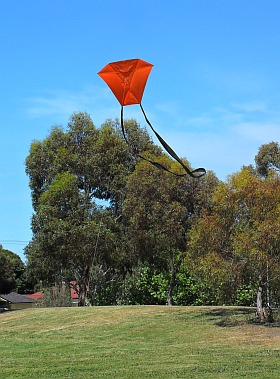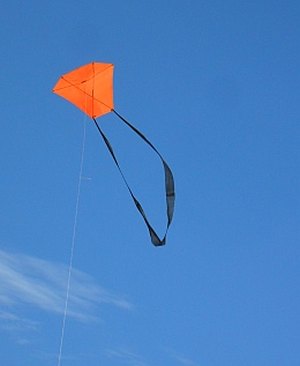- Home Page
- Flight Reports
- Sticked Barn Doors
- 2-Skewer Barn Door
2-Skewer Barn Door Kite
Strong Thermals and Gusts!
According to weather reports, today was going to be the last sunny one for some time, so it was an easy decision to go out and fly. This latest build of the 2-Skewer Barn Door kite hasn't yet been the subject of a full flight report, so that was another good reason.
 MBK 2-Skewer Barn Door
MBK 2-Skewer Barn DoorJust before leaving home, the weather website I refer to these days was indicating winds of 12 kph gusting to 22 kph. That didn't seem like a problem, since the recent test flight of this kite was done in similar winds.
Just to be safe, I shifted the towing point forward by about a centimeter (1/2 inch).
For
a while, the bright-orange barn door flitted around close to the ground as I tried to get a few good closeup shots. It's nice to get some
trees and grass in these pictures rather than plain blue sky.
Meanwhile, the cloud cover overhead was thin, streaky, and mid-level.
It was higher than cumulus but couldn't really be called high-altitude cirrus either. Now,
after working the camera's autofocus overtime, it was time to let the
kite climb a bit higher.
The small
barn door was up to its usual tricks, flying sideways for extended
periods before straightening up and soaring high in the
moderate-strength gusts.
Initially, it wasn't sensible to let out more than 60 meters (200 feet) of line. This was because the wind was blowing across the reserve, limiting the space available. Power lines, houses, and trees beckoned not much more than 60 meters downwind!
On this site, there's more kite-making info than you can poke a stick at. :-) Want to know the most convenient way of using it all?
The Big MBK E-book Bundle is a collection of downloads—printable PDF files which provide step-by-step instructions for many kites large and small.
That's every kite in every MBK series.
 Looped tail tested!
Looped tail tested!However,
since there were very few cars within the reserve grounds, I sneaked
across an access road and gained much more flying space. Soon, 90 meters
(300 feet) of line was out, and the bow became more pronounced despite
the windy conditions. Hey, the 2-Skewer Barn Door kite is less than 60 centimeters (48 inches) across.
The 2-Skewer Barn Door kite was being pushed hard,
occasionally being forced down to just above tree height before
recovering in the slower air down there. There were also magnificent
climbs and swoops as the bending bamboo and tape-edged plastic tussled
with the relentless air pressure. This was particularly spectacular to
watch when the kite was speeding past areas of cloud.
Thermal
turbulence would sometimes cause abrupt changes in flight as the kite
stalled and then took off in a new direction. There were also moments of
relative smoothness when the looped black-plastic tail would just hang
with hardly a ripple.
It became clear after half an hour or so
that the wind speed was increasing—quite a bit! At times when the kite
was low, the tops of the trees behind it could be seen lashing from side
to side. No wonder the little barn door was grimacing with the strain.
In
the end, the 2-Skewer Barn Door kite ended up on the ground, and I
called it a day. One of the diagonal spar tips was a bit sharp-edged and
had punched through the cap tape. That caused a bit of sail slippage,
which might have been the real reason the kite had come down. The
maximum gust strength above the trees' height must have been about
30 kph or more.
Back home, I removed the flying line, sanded the
sharp-edged bamboo tip a bit smoother, and patched up the sail corner
with a short length of tape. The tail had rolled up tight in several
sections too, so that was another job.
In light enough winds, these tails will actually stay unrolled.
It's good to have a 2-Skewer Series kite to take out when it's clearly too windy for most of the other flat kites in the series.
In
a somewhat secluded location, the wind meter had recorded an average
wind speed of 6.6 kph and a maximum gust of 20 kph. However, on getting
home and checking that online weather site again, it had changed to
20 kph gusting to 30!
The story or stories above document actual flying experiences. My write-ups are definitely "warts and all," since things don't always go totally as planned. However, half the fun of kiting is anticipating the perfect flight. When it happens, it's magic!
As mentioned earlier, there's more kite-making info here than you can poke a stick at. :-)
Want to know the most convenient way of using it all?
The Big MBK E-book Bundle is a collection of downloads—printable PDF files which provide step-by-step instructions for many kites large and small.
That's every kite in every MBK series.
